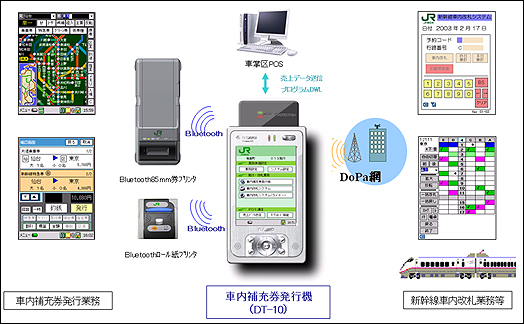The Success Story from East Japan Railway Company
Summary of the story
| Country | : Japan |
|---|---|
| Distributor | : Casio Computer Co., Ltd. |
| Customer | : East Japan Railway Company |
| Location | : Business area of East Japan Railway Company |
| Terminal | : IT-10 |
| Business Type | : Transportation |
Onboard Supplementary Ticket Terminal
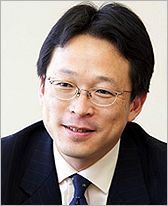
Mr. Tokunaga is answering in detail about the project to interviewer.
4,500 mobile terminals
CASIO IT-10
have been deployed for corporate use as conductor terminals to accompany the renewal of the "Onboard Supplementary Ticket Terminal" used for issuing tickets aboard the trains of the East Japan Railway Company (hereafter
JR-East
).
With this renewal, a single
CASIO IT-10
cannot only be used to issue tickets but also check boarding information about Shinkansen (bullet train) automated ticket gates, making efficient onboard service by conductor and better customer service possible.
To find out more about the reasons for making the final decision with the CASIO IT-10 , improvement in the service after the deployment and future deployment prospects, Mr. Tokunaga who is the project leader in Transport & Rolling Stock Department of Railway Operations Headquarters in JR-East * has been interviewed.
* Company profile is at the end of story
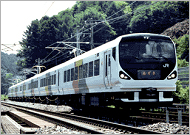
An express train,
"Azusa", Type E257

A new shinkansen (bullet train) "Hayate", Type E2-1000
Background to the Deployment
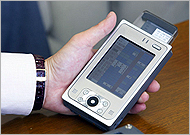
CASIO IT-10 in
Mr. Tokunaga's palm
A careful consideration over cost reduction and the future expandability led to our first deployment of Windows based mobile terminal.
Traditionally, onboard ticket issuing was an extremely bothersome task involving either writing out or punching holes in tickets by hand. Some 15 years ago in 1990, an "onboard supplementary ticket terminal" was introduced originally with the aim of improving work efficiency. Since then renewals have been repeated and this renewal is fourth for the system.
The point should be focused on this renewal is the onboard supplementary ticket terminal - in other words, the innovations to the conductor's terminal.
The interview with Mr. Tokunaga continues, "Why did
JR-East
adopt a Windows based mobile terminal ?" And he replied; "The fact is that we examined carefully two choices, 1) do we upgrade the version of the existing dedicated terminal or 2) do we change to the hardware and software with Windows OS integrated for great possibility of general use and thus innovate the interface? In the outcome we judged the latter to be the victor for two reasons - system expandability and cost reduction in development of the system and for the daily onboard service."
In this way, the sights have been set for development linked to the future - thumbs up to the Windows OS based mobile terminal.
Assessing on the superb visibility, prolonged operability and environment performance featured by IT-10
"With regard to actual circumstances of the use, the functions of the conductor's terminal need to be not only flexible but also easy to use and durable as well", said Mr. Tokunaga.
"At the time of the renewal, we have considered about putting all the operating functions in a big and easy-to-see screen. While a major point to be considered from the nature of conductor work - where they do not return for about 24 hours once they have boarded trains to a facility for charging the installed battery pack - is the charged lifespan of the terminal's battery. Further, because it can be assumed that the conductors will be using terminals outside at local stations without roofs, consideration had to be given to the environment performances such as drop durability, dust and water-splash proofing. Based on these points, we examined the issues jointly with JR East Japan Information Systems Company
**
, who are involved in work for the system integration of our corporate group, and arrived at a decision."
Examination of these considerations resulted in the
CASIO IT-10
being chosen because it has highly acclaimed features like a big 3.7-inch color TFT LCD that provides good visibility, a large-capacity battery that runs for approximately 27 hours, and environment performance with dropped impact from a height of 1.0 m and water/dust proof that comply with the IP54 level of IEC60529 standard.
** Company profile is at the end of story.
Choosing a terminal not just for issuing tickets but also for general use in a wide range of tasks

His expertise convinces how the terminal can contribute the minimization of operation costs.
For JR-East there was an intention from the outset of development to have a terminal that can be used for a variety of work beyond just issuing tickets. Mr. Tokunaga was asked; how the work of conductors will change if they can do a variety of tasks with a single terminal? "A conductor's task includes many others such as opening and closing doors, checking for safety, and onboard ticket issuing. Moreover, he has to move about, so there is a limit to how many dedicated terminals they can carry around for each individual task. Thus, if a variety of tasks can be managed and controlled with a single terminal, the tasks will become easier, the efficiency will increase, the service given to customers can be more kind, and the quality of task thus enhanced."
Mr. Tokunaga continued by elaborating about the cost reduction.
"There are various distinctions such as the operational ability required depending on the area and the kind of trains to serve (in the case of
JR-East
, operating over 12,000 trains per day, these include trains such as the Shinkansen (bullet train), long-distance express, short-distance express, local train and etc.). Some people feel that there should be a dedicated terminal for each type of service, but that would cost too much. However, with the
CASIO IT-10
and its devised application software, the conductor's terminal can be optimized to deal with any area within the
JR-East
business territory and any kind of the trains, without incurring excessive costs. Points like this led to us choosing the
CASIO IT-10
."
The system in detail

All the onboard tasks are processed with CASIO IT-10 while on the move.
Possibilities unfold - seating data secured while on the move, tickets clipped onboard and tickets sold at stations
The greatest change derived from the renewal is the broad improvement in the ticket retailing function. Conductors now move through the compartments carrying the terminal with downloaded data of the latest fare prices to make simultaneous fare adjustments and ticket issues.
JR-East
is already providing a service on the Shinkansen train in which the data of tickets passed through the Shinkansen-dedicated automated ticket gates will be transferred to the terminal via wireless WAN communication (DoPa network) to eliminate onboard ticket clipping. And the terminal that provides this function has been integrated into the
CASIO IT-10
onboard supplementary ticket terminal.
Meanwhile, there are two types of printer available for issuing passenger tickets; a thermal printer for onboard issuing with importance placed on the print speed and the other, a station printer that prints out magnetic stripe tickets in the same size as the tickets sold at ordinary ticket counter that allow the passage through automated ticket gates. Furthermore, both the printers are geared to output using Bluetooth wireless communication.
Effect of the Deployment

The railroad map of the JR-East
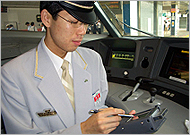
A conductor processes the rest of his onboard tasks in crew cabin.
Improvements with interface and the operability have achieved easy use and great operating efficiency
Mr. Tokunaga was asked again about the outcome after the renewal.
"Because less time is required for regular onboard tasks, there is more free time available for other tasks - which means that we have achieved prompt operations and better service."
Conversely, were there onsite uncertainties, etc., about operating the innovated conductor's terminal?
"No. We are often being told by those on site that the new terminals are easier to use because of the improved interface. The operational concept with the conductor's terminal was designed to bring its operations closer to those of ticket vending machines used in stations. In fact, as about half of our conductors have had experience of working in stations, their acclimatization to operating the new terminal was far smoother than we expected." He went on saying, "The business area of
JR-East
is the widest of any of other Japan's railway companies. And we really wanted to realize the dream of putting the entire map of the area on screen for operation access; therefore, we had to consider and repeatedly work out through trial and error all the various interface patterns such as the optimum size for characters, panel brightness, color usage, and screen switching."
The effort expended to fulfill such onsite expectations is reflected in the remarkable improvement to the interface.
Utilizing IT-10 achieves prolonged operation time without sacrificing the lightweight
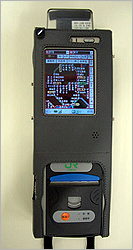
The terminal is housed in a soft case when it is combined with the printer as a single unit.
The lightweight of the conductor's terminal after the renewal has won many plaudits. To fulfill the onsite requirement of prolonged operation time, the battery capacity has to be increased, which consequently makes the terminal body heavier.
Mr. Tokunaga went on saying, "Lightening the terminal was a big theme of this project. And the
CASIO IT-10
cleared this hurdle for us."
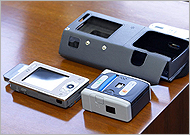
The printer can be used even when detached from the terminal.
"The conductor's terminal is used in tandem with the printer, but because we are using Bluetooth wireless communication, the printer can be used in a detached state - for example, hung to a waist belt by itself. In this way the terminal in hand weighs only half or less (approximately 290g) than the previous terminal."
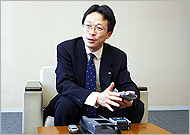
Mr. Tokunaga concluded his interview with the future prospects in confident.
"We want to expand the system so that it becomes a comprehensive terminal for conductors - i.e., provide electronic money settlement and pass on railway service situations via transmissions, etc.", said Mr. Tokunaga.
Mr. Tokunaga had this to say about future prospects for making greater use of the onboard supplementary ticket terminal system: "We want to strengthen the communication environment to be able to make various real-time data deliveries - for example, in relation to providing a barrier-free service for the disabled, we would transmit information such as the boarding and alighting stations of people requiring assistance, so that conductors can act to help.
Company profiles
JR-East
| Company name | : East Japan Railway Company |
| Address | : 2-2-2, Yoyogi, Shibuyaku, Tokyo 151-8578, Japan |
| No. of employees | : 67,710 |
| No. of stations | : 1,699 |
| Average daily train runs | : 12,478 |
| Passenger line network | : 7,526.8 kilometers |
| Passengers served daily | : About 16.0 million (average of the year ended March 31, 2005) |
| Business areas | : Passenger railways, travel agency services, financial services, etc. |
JR East Japan Information Systems
| Company name | : JR East Japan Information Systems Company |
| Address |
: JR East Head Office Bldg. 9F, 2-2-2, Yoyogi, Shibuyaku,
Tokyo 151-0053, Japan |
| No. of employees | : 1,296 (as of June 1, 2005) |
| Sales revenues | : 54.6 billion yen (the fiscal year 2004) |
| Business activities |
: Information processing outsourcing, provision of information services,
development and operation of information processing systems, etc. |
